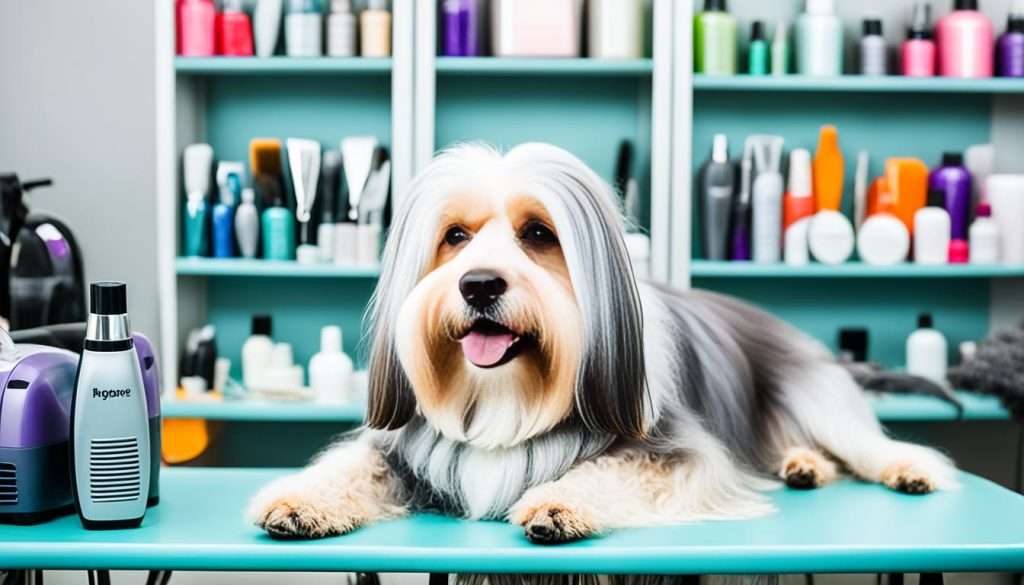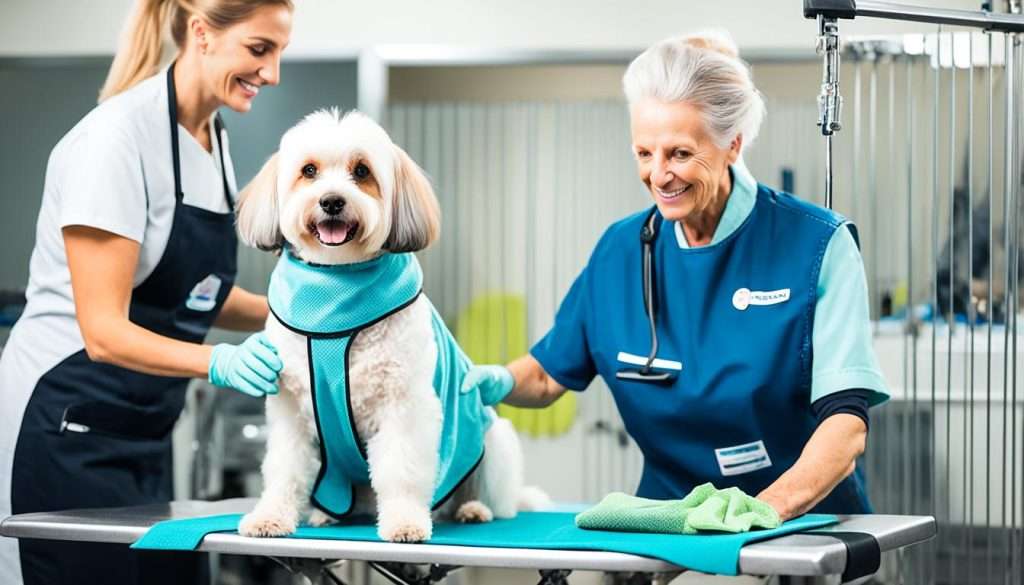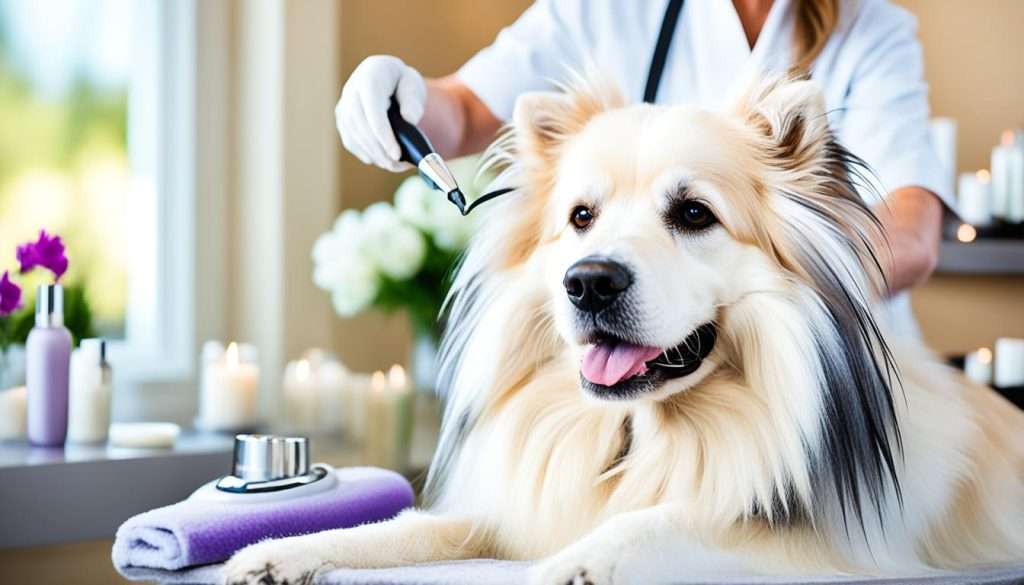Grooming is an essential part of caring for senior dogs. As dogs age, their grooming needs change. Senior dogs may experience physical changes such as coat and skin changes, muscle mass and mobility issues, weight changes, dental changes, eyesight and hearing changes, energy level changes, joint and bone changes, and cognitive changes. Regular grooming for senior dogs is important for their coat and skin health, mobility and comfort, temperature regulation, ear and eye health, dental health, nail care, and overall wellness.
Physical Changes In Senior Dogs
Aging brings about various physical changes in senior dogs. These changes include:
- Coat and Skin Changes: Differences in coat texture and color, thinner and drier coats, hair thinning and slow regrowth, shedding, matting, and tangles.
- Muscle Mass and Mobility: Loss of muscle mass, decreased mobility and balance.
- Weight Changes: Weight gain or loss.
- Dental Changes: Dental problems.
- Eyesight and Hearing Changes: Diminished eyesight and hearing.
- Energy Level Changes: Reduced energy levels.
- Joint and Bone Changes: Weaker bones and joints.
- Cognitive Changes: Cognitive decline.
These physical changes impact their grooming needs and techniques. Senior dogs require special attention and care during grooming to accommodate these changes.
Importance of Grooming Your Senior Dog
Grooming remains important for senior dogs to maintain their overall health and well-being. Regular grooming helps to improve their coat and skin health, enhance mobility and comfort through appropriate trimming of fur, regulate body temperature in different weather conditions, ensure ear and eye health by cleaning and detecting any issues, maintain dental health through teeth brushing, care for nails to prevent pain and injuries, serve as a wellness checkup by monitoring physical condition, and strengthen the bond between senior dogs and their owners through positive physical contact.
As senior dogs age, their grooming needs change, and proper grooming practices become even more vital. Let’s explore the benefits of grooming for senior dogs in more detail:
Coat and Skin Health
Grooming plays a crucial role in maintaining the coat and skin health of senior dogs. Regular brushing removes dead hair and stimulates the natural oils in the skin, promoting a healthy and shiny coat. It also helps to prevent matting and tangling, which can cause discomfort and skin irritation.
Mobility and Comfort
Trimming the fur around your senior dog’s paw pads and nails can improve their mobility and comfort. Overgrown hair in these areas can make walking difficult and cause them to slip on smooth surfaces. Keeping their fur well-groomed reduces the risk of accidents and enhances their overall mobility.
Temperature Regulation
Senior dogs are more susceptible to temperature extremes. Regular grooming helps to regulate their body temperature by ensuring their coat is well-maintained. In warmer weather, removing excess hair can prevent overheating, while in colder weather, a longer coat provides insulation and warmth.
Ear and Eye Health
Grooming provides an opportunity to regularly check and clean your senior dog’s ears and eyes. By keeping these areas free from dirt, debris, and excess wax, you can help prevent infections and other issues that may cause discomfort or vision problems.
Dental Health
Like humans, senior dogs can develop dental issues that can lead to pain, infections, and even systemic health problems. Regular teeth brushing as part of the grooming routine helps to maintain good dental health and prevent these issues from occurring.
Nail Care
Overgrown nails can cause discomfort and pain for senior dogs, potentially leading to issues with walking and joint health. Trimming their nails regularly as part of the grooming routine ensures their paws remain healthy and minimizes the risk of injuries.
Wellness Checkup
Grooming sessions provide an excellent opportunity to give your senior dog a wellness checkup. During grooming, you can closely examine their skin, fur, ears, eyes, teeth, and overall physical condition. This allows you to detect any potential health concerns early and seek veterinary attention if necessary.
Bonding with Owners
Grooming is a bonding experience between senior dogs and their owners. It provides an opportunity for physical contact, positive reinforcement, and trust-building. Regular grooming sessions can strengthen the bond and enhance the emotional well-being of both dogs and their owners.
In conclusion, grooming plays a significant role in maintaining the overall health and well-being of senior dogs. By incorporating regular grooming into their care routine, you can ensure their coat and skin health, promote mobility and comfort, regulate body temperature, maintain ear and eye health, prevent dental issues, care for their nails, perform wellness checkups, and strengthen the bond between you and your beloved senior dog.

Essential Grooming Tips For Senior Dogs
Proper grooming plays a crucial role in maintaining the health and well-being of senior dogs. As our furry companions age, their grooming needs may change, requiring special attention and care. To help you ensure that your senior dog stays clean, comfortable, and healthy, here are some essential grooming tips:
Brushing and Coat Care
Choosing the right brushes and combs for your senior dog’s specific coat type is essential. Different coats, such as short, long, curly, or wiry, require different grooming tools. Use soft bristle brushes to avoid irritating their sensitive skin and brush your senior dog’s coat as often as needed to remove loose hair, tangles, and mats. Regular brushing not only keeps their coat looking tidy but also helps distribute natural oils, promoting a healthy skin and coat.
Bathing and Skin Care
When it comes to bathing your senior dog, select shampoos that are suitable for their specific coat and skin type. Use lukewarm water to avoid discomfort and gently massage the shampoo into their coat, ensuring a thorough clean. Rinse your dog properly to remove all shampoo residue. After bathing, pat them dry with a soft towel, making sure they are completely dry to prevent skin irritations. Avoid using a blow dryer as it can be noisy and may cause anxiety for your senior dog.
Nail Trimming
Regular nail trimming is crucial for senior dogs to prevent their nails from becoming too long and uncomfortable. Use the right tools, such as dog nail clippers or a grinder, and learn the proper technique to avoid hurting your dog. Be cautious not to cut too close to the quick, which is the sensitive part of the nail containing blood vessels. If you’re unsure about nail trimming, consult a professional groomer or a veterinarian for guidance.
Ear Cleaning
Ears are a major concern for senior dogs as they may develop issues like infections or excessive wax buildup. To clean your senior dog’s ears, use a suitable ear cleaner recommended by your veterinarian. Gently massage the base of the ear to allow the cleaner to reach deep into the ear canal. Wipe away any excess cleaner and debris with a clean, soft cloth or a cotton ball. Regular ear cleaning helps prevent ear infections and ensures your dog’s ears stay healthy.
Dental Care
Oral hygiene is as important for senior dogs as it is for humans. Brushing your senior dog’s teeth regularly helps prevent dental diseases, bad breath, and tooth loss. Use a soft-bristled toothbrush and dog-friendly toothpaste to gently brush their teeth. Start with short sessions to get your dog accustomed to the brushing process. If your dog is resistant to toothbrushing, there are alternative options available, such as dental wipes or dental chews recommended by veterinarians.
| Grooming Tips For Senior Dogs | Benefits |
|---|---|
| Regular brushing and coat care | Keeps their coat clean, promotes a healthy skin and coat, and reduces shedding. |
| Proper bathing and skin care | Maintains skin health, removes odor-causing bacteria, and prevents skin irritations. |
| Regular nail trimming | Prevents nail overgrowth, discomfort, and potential injuries. |
| Consistent ear cleaning | Prevents ear infections, reduces discomfort, and maintains ear health. |
| Dental care | Prevents dental diseases, promotes fresh breath, and supports overall health. |
By following these grooming tips, you can ensure that your senior dog remains clean, comfortable, and healthy throughout their golden years. Remember, if you are unsure about any aspect of grooming, consult with a professional groomer or your veterinarian for guidance and assistance.
References:
- Grooming for Older Dogs: Changes and Challenges
- Grooming Senior Dogs 101
- Grooming Tips for Older Dogs
Safety Measures During Senior Dog Grooming
When grooming your senior dog, it is crucial to prioritize their safety and well-being. Implementing proper safety measures ensures a comfortable and stress-free grooming experience for your furry companion. By taking the following precautions, you can create a safe environment that caters specifically to their needs.
Environmental Accommodations
One essential safety measure is providing non-slip surfaces in the grooming area. This prevents your senior dog from slipping or injuring themselves during grooming. Consider using rubber mats, towels, or carpets to ensure stability while they are being groomed.
Comfortable Grooming Area
Creating a comfortable grooming area is equally important. Place soft blankets or orthopedic beds where your senior dog can lie down or sit during grooming. This helps to reduce strain on their joints and provides a cozy space for them to relax.
Handling and Restraint
Ensure that you use gentle handling techniques when grooming your senior dog. Handle them with care, and avoid any sudden or forceful movements that can cause distress or discomfort. Patience and understanding are key in maintaining a positive grooming experience for your furry friend.
Slow and Calm Movements
During grooming, it is crucial to maintain a calm atmosphere. Engage in grooming activities at a slow and relaxed pace, minimizing any potential stress or anxiety for your senior dog. A peaceful environment promotes a more enjoyable grooming session for both of you.
By implementing these safety measures, you can safeguard your senior dog’s well-being and make their grooming experience pleasant and comfortable.

| Safety Measures | Description |
|---|---|
| Environmental Accommodations | Provide non-slip surfaces such as rubber mats, towels, or carpets to prevent slipping and injuries. |
| Comfortable Grooming Area | Create a cozy grooming area with soft blankets or orthopedic beds to reduce strain on joints and ensure comfort. |
| Handling and Restraint | Use gentle handling techniques and avoid sudden or forceful movements to prevent distress or discomfort. |
| Slow and Calm Movements | Maintain a calm atmosphere during grooming, engaging in activities at a slow and relaxed pace. |
Professional Grooming vs. At-Home Grooming for Senior Dogs
When it comes to grooming senior dogs, both professional grooming and at-home grooming have their advantages. Let’s explore the benefits of each option:
Professional Grooming
Professional groomers, especially those experienced in dealing with senior dogs and health conditions, offer specialized care tailored to the unique needs of older dogs. Here are the benefits of opting for professional grooming:
- Expert Care: Professional groomers undergo training to understand the specific grooming requirements of senior dogs. They can handle physical changes, such as fragile skin, arthritis, or joint pain, with care and expertise.
- Abnormality Detection: Groomers often have a keen eye for abnormal conditions or changes in a dog’s appearance. They can identify potential health issues like skin infections, lumps, or ear problems, and suggest visiting a veterinarian if necessary.
- Pampering Experience: Senior dogs can enjoy a soothing and relaxing grooming session at the hands of professionals. Groomers use gentle techniques, ensuring the comfort and well-being of your furry friend.
At-Home Grooming
If you prefer the comfort and convenience of grooming your senior dog at home, here are the benefits of at-home grooming:
- Familiar Environment: Senior dogs often find comfort in familiar surroundings. Grooming them at home provides a sense of security that can help reduce stress and anxiety during the grooming process.
- Regular Grooming Routine: By grooming your senior dog at home, you can establish a consistent grooming schedule that suits their needs. This helps maintain their coat and skin health, as well as overall cleanliness.
- Health Monitoring: During at-home grooming sessions, you have the opportunity to closely observe your senior dog. This allows you to monitor any changes in their skin, coat, teeth, or general well-being, and seek veterinary care if needed.
Ultimately, the choice between professional grooming and at-home grooming depends on your senior dog’s individual needs and your personal preferences. Some owners may prefer the expertise and convenience of professional grooming, while others may find comfort in taking care of their furry friend’s grooming needs themselves.

Conclusion
Grooming for senior dogs is crucial to their well-being and overall health. As dogs age, their grooming needs change, and it’s essential to adapt the grooming routine accordingly. Regular grooming helps to maintain their physical health, comfort, and overall well-being, ensuring they look and feel their best in their golden years.
By following essential grooming tips and taking safety measures, you can make grooming sessions effective and enjoyable for your senior dog. Whether you choose professional grooming or at-home grooming, the goal remains the same: to keep your senior dog clean, comfortable, and healthy.
Remember to brush their coat regularly, use appropriate shampoos for bathing, trim their nails carefully, clean their ears gently, and prioritize dental care. Additionally, create a safe and comfortable grooming environment by providing non-slip surfaces and ensuring calm handling and movements.
Regular grooming not only keeps your senior dog looking their best but also strengthens the bond between you and your furry companion. It’s a time for physical contact, pampering, and monitoring their overall health. Embrace the opportunity to provide loving care and attention to your senior dog during grooming sessions.
Whether you choose to bring your senior dog to a professional groomer or take on the task at home, grooming for senior dogs plays a vital role in their happiness and well-being. With some extra care and attention, you can ensure that your senior dog looks and feels their best as they navigate their golden years.
Tips for Effective Senior Dog Grooming:
- Regularly brush your senior dog’s coat to remove loose hair and prevent matting.
- Use appropriate shampoos and grooming products for their specific needs.
- Trim their nails carefully to maintain comfort and prevent injuries.
- Clean their ears gently to prevent infections.
- Pay attention to their dental health by brushing their teeth regularly.
- Create a safe and comfortable grooming environment with non-slip surfaces.
- Handle them gently and provide reassurance throughout the grooming process.
References
When it comes to grooming for senior dogs, it’s important to have reliable sources of information. Here are three recommended references that provide valuable insights and tips for grooming older dogs:
- “Grooming for Older Dogs: Changes and Challenges” – Source: [Link]
- “Grooming Senior Dogs 101” – Source: [Link]
- “Grooming Tips for Older Dogs” – Source: [Link]
These references cover a range of topics related to grooming for senior dogs, including important changes to consider, essential grooming techniques, and helpful tips to ensure a comfortable grooming experience, whether at home or with the help of a professional groomer.
Remember, senior dog grooming requires special attention and care to accommodate their unique needs. By referring to these trusted sources, you can gather valuable information to enhance your senior dog’s grooming routine and contribute to their overall well-being.
FAQ
What physical changes can I expect in my senior dog?
Senior dogs may experience changes in their coat and skin, muscle mass and mobility, weight, dental health, eyesight and hearing, energy levels, joints and bones, and cognitive abilities.
Why is grooming important for senior dogs?
Regular grooming for senior dogs is important to maintain their overall health and well-being, including their coat and skin health, mobility and comfort, temperature regulation, ear and eye health, dental health, nail care, and overall wellness.
What are some essential grooming tips for senior dogs?
Some essential grooming tips for senior dogs include brushing and coat care, bathing and skin care, nail trimming, ear cleaning, and dental care.
What safety measures should I take during senior dog grooming?
It is important to provide non-slip surfaces, create a comfortable grooming area, allow them to lie down or sit, use gentle handling techniques, and employ slow and calm movements.
Should I opt for professional grooming or at-home grooming for my senior dog?
Both professional grooming and at-home grooming have their benefits. Professional groomers can provide expert care tailored to the specific needs of senior dogs, while at-home grooming allows for regular grooming sessions in a familiar environment, reducing stress and anxiety.
How can I ensure the comfort and well-being of my senior dog during grooming?
You can ensure the comfort and well-being of your senior dog during grooming by providing non-slip surfaces, creating a comfortable grooming area, using gentle handling techniques, and employing slow and calm movements.
What references were used for this article?
“Grooming for Older Dogs: Changes and Challenges”, “Grooming Senior Dogs 101”, “Grooming Tips for Older Dogs”